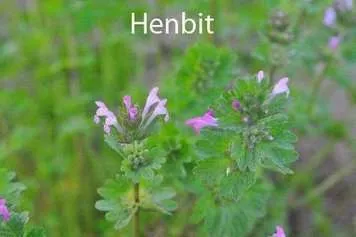Henbit and other winter annuals, such as chickweed and speedwell, germinate in the fall but are most noticeable in the spring. However, if chemical control efforts are delayed until spring, their effectiveness is usually very limited. Although this article focuses on henbit, the comments on control apply to chickweed and speedwell as well.
How do you know you have henbit? See if it meets this description: Henbit has squarish stems and small, rounded, deeply veined leaves (less than 1 inch across when mature) with lobes along the margin. The upper leaves have no petiole (stalk); that is, they are attached directly to the stem. The flowers are pinkish-purple and shaped like a tiny trumpet. Flowers are abundant during April. “Stands” of henbit are actually quite attractive when in full bloom.
There are several options to reduce the growth of these weeds. As stated above, chemical controls in the spring are not very effective on henbit. You will get some suppression with combination products such as Weed Free Zone, Trimec, Weed-Out, Weed Stop 2X or Weed-B-Gon, but complete control is unlikely. It is usually best to just mow regularly and give your lawn an application of nitrogen in early May, assuming you haven’t done so already in the spring. This is for cool-season lawns; early May would be too early for to fertilizer warm-season grasses such as Bermuda, zoysia or buffalograss. Because henbit and chickweed are winter annuals, they will die when temperatures become hot.
Control is much easier in the fall of the year. There are two possible courses of action, as far as herbicides go. The first is to apply a preemergence herbicide in early to mid-September. This will prevent henbit and other winter annuals from germinating. Preemergence herbicides labeled for both henbit and chickweed include prodiamine (Barricade), dithiopyr (Dimension), isoxaben (Gallery, Fertilome Broadleaf Weed Control), pendimethalin (Halts and others), oryzalin (Surflan and Weed Impede and XL. All but Surflan, Weed Impede and XL are also labeled for speedwell.
The second course of action is to wait until late October or early November (after most henbit has germinated) and use a postemergence broadleaf herbicide, such as Weed Free Zone, Trimec, Weed-Out, Weed Stop 2X or Weed-B-Gon. With this approach, most of the henbit will be killed but, because small numbers of henbit continue to germinate through the late fall and winter, some plants may be missed. This approach works well because henbit is relatively easy to kill in the fall and many people want to treat for dandelions at that time (i.e., October) anyway. Just remember you may have to do some spot-spraying in the spring if you want to get all the henbit. As a final note, henbit will not be very competitive in dense, healthy lawns, so good cultural management will reduce the need for herbicides.





